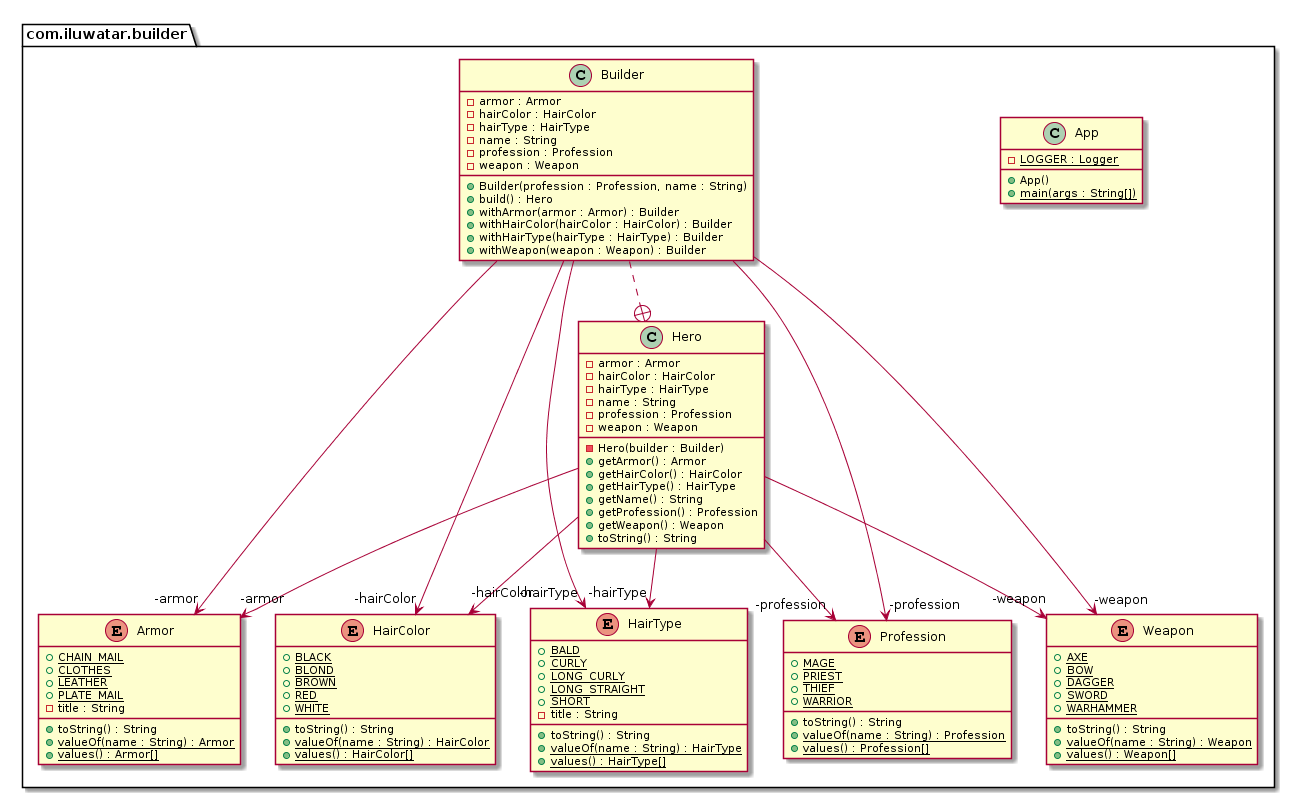public enum Armor {
CLOTHES("clothes"), LEATHER("leather"), CHAIN_MAIL("chain mail"), PLATE_MAIL("plate mail");
private final String title;
Armor(String title) {
this.title = title;
}
@Override
public String toString() {
return title;
}
}
public enum HairColor {
WHITE, BLOND, RED, BROWN, BLACK;
@Override
public String toString() {
return name().toLowerCase();
}
}
public enum HairType {
BALD("bald"), SHORT("short"), CURLY("curly"), LONG_STRAIGHT("long straight"), LONG_CURLY(
"long curly");
private final String title;
HairType(String title) {
this.title = title;
}
@Override
public String toString() {
return title;
}
}
public enum Profession {
WARRIOR, THIEF, MAGE, PRIEST;
@Override
public String toString() {
return name().toLowerCase();
}
}
public enum Weapon {
DAGGER, SWORD, AXE, WARHAMMER, BOW;
@Override
public String toString() {
return name().toLowerCase();
}
}
public final class Hero {
private final Profession profession;
private final String name;
private final HairType hairType;
private final HairColor hairColor;
private final Armor armor;
private final Weapon weapon;
private Hero(Builder builder) {
this.profession = builder.profession;
this.name = builder.name;
this.hairColor = builder.hairColor;
this.hairType = builder.hairType;
this.weapon = builder.weapon;
this.armor = builder.armor;
}
public Profession getProfession() {
return profession;
}
public String getName() {
return name;
}
public HairType getHairType() {
return hairType;
}
public HairColor getHairColor() {
return hairColor;
}
public Armor getArmor() {
return armor;
}
public Weapon getWeapon() {
return weapon;
}
@Override
public String toString() {
var sb = new StringBuilder();
sb.append("This is a ")
.append(profession)
.append(" named ")
.append(name);
if (hairColor != null || hairType != null) {
sb.append(" with ");
if (hairColor != null) {
sb.append(hairColor).append(' ');
}
if (hairType != null) {
sb.append(hairType).append(' ');
}
sb.append(hairType != HairType.BALD ? "hair" : "head");
}
if (armor != null) {
sb.append(" wearing ").append(armor);
}
if (weapon != null) {
sb.append(" and wielding a ").append(weapon);
}
sb.append('.');
return sb.toString();
}
public static class Builder {
private final Profession profession;
private final String name;
private HairType hairType;
private HairColor hairColor;
private Armor armor;
private Weapon weapon;
public Builder(Profession profession, String name) {
if (profession == null || name == null) {
throw new IllegalArgumentException("profession and name can not be null");
}
this.profession = profession;
this.name = name;
}
public Builder withHairType(HairType hairType) {
this.hairType = hairType;
return this;
}
public Builder withHairColor(HairColor hairColor) {
this.hairColor = hairColor;
return this;
}
public Builder withArmor(Armor armor) {
this.armor = armor;
return this;
}
public Builder withWeapon(Weapon weapon) {
this.weapon = weapon;
return this;
}
public Hero build() {
return new Hero(this);
}
}
}
public class App {
private static final Logger LOGGER = LoggerFactory.getLogger(App.class);
public static void main(String[] args) {
var mage = new Hero.Builder(Profession.MAGE, "Riobard")
.withHairColor(HairColor.BLACK)
.withWeapon(Weapon.DAGGER)
.build();
LOGGER.info(mage.toString());
var warrior = new Hero.Builder(Profession.WARRIOR, "Amberjill")
.withHairColor(HairColor.BLOND)
.withHairType(HairType.LONG_CURLY).withArmor(Armor.CHAIN_MAIL).withWeapon(Weapon.SWORD)
.build();
LOGGER.info(warrior.toString());
var thief = new Hero.Builder(Profession.THIEF, "Desmond")
.withHairType(HairType.BALD)
.withWeapon(Weapon.BOW)
.build();
LOGGER.info(thief.toString());
}
}
|

